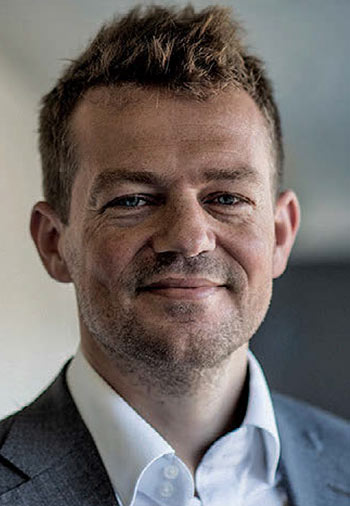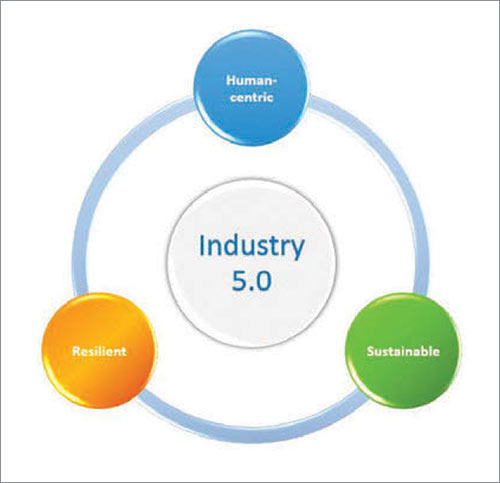Industry News
- Home
- Industry News
Since 2011, when Germany launched the notion of Industry 4.0, manufacturing has been dominated by an ongoing process of digitalization. The emergence of machine-to-machine communication, connectivity and smart technology, all aimed at largely eliminating the need for human intervention, are gradually but steadily finding adoption. Time for a rethink?
The connected, data-driven, digital world of Industry 4.0, a concept coined a decade ago originally for a project in the high-tech strategy of the German government to promote the digitalization of manufacturing, still remains a far-off goal for many factories and plants. The term, which was publicly introduced in 2011 at the Hannover Messe, refers to the paradigm shift taking place from centralized to decentralized smart manufacturing and production. It conjures up visions of a smart factory where industrial production machinery no longer simply “processes”the product, but ‘the product communicates with the machinery to tell it exactly what to do’, as Germany Trade & Invest (GTAI) has explained. And it is generally agreed that embracing Industry 4.0-and the digital manufacturing and the interconnectivity that comes with it-paves the way for companies towards greater agility, flexibility and operational performance.

Yet Industry 4.0 is still very much a work in progress. As Esben H. Østergaard, at the time CTO at Universal Robots, noted in a 2018 article published among others in InTech Magazine: “Although Industry 4.0 still has not scaled up to cover a significant percentage of manufacturing setups, its vision of near-total automation-and the resulting cost savings-has clearly captured the industry's imagination. More importantly, even though the "lights-out" factory is still a rare phenomenon, the connected automation technologies that form the backbone of Industry 4.0 are being widely and increasingly deployed.”
That said a very considerable number of companies also still remains firmly rooted in Industry 4.0’s predecessor: the Digital Revolution known as Industry 3.0 These companies are still grappling with the implications of having to evolve into a more digitalised version of themselves and many are still unclear about how to get there.
Uncertain about the investment required, unsure about the benefits and, for the most part, lacking the expertise and skills to implement and use the technology, these are the companies where, as the joke goes, EPR still stands for ‘Excel-run production.
Yet, while the adoption of Industry 4.0 technologies is still far from universal, further developments, in the form of a new model, are already looming on the horizon. Industry 5.0 is coming-and it promises to be a horse of a completely different colour.
What has characterised each new industrial revolution up until now – and Industry 4.0 is no exception - is that the focus has been on the development of powerful and innovative technology and machines that increase manufacturing productivity and efficiency, and minimise human involvement. And while today's smart, interconnected facilities can successfully achieve those aims, in other respects they can come up short.
While essentially a technological shift, the actual impact of Industry 4.0 on the industry extends considerably beyond technology alone. There are three relevant dimensions of change in relation to Industry 4.0: technological change, social change and change in the business paradigm. That a transformed industry will have a transformative impact on society as well was one of the points made by the authors of a policy brief entitled Industry 5.0: Towards a sustainable, human-centric and resilient European industry, which was produced in January of this year by the Directorate- General for Research and Innovation (DG RTD) of the European Commission. They noted that ‘this is foremost true for industry workers, who may see their role changed or even threatened. Changing roles and increased reliance on complex technologies will require new skills. 'Without an understanding of how these roles will change and what these new skills might be, manufacturing workers have long resisted change, fearing marginalization or the ultimate loss of their jobs. ‘Increasing automation may undermine industry's societal role as an employer and engine of prosperity', notes the DG RTD. It has developed a vision for the future of European industry that has become known as Industry 5.0. This vision ‘recognises the power of industry to achieve societal goals beyond jobs and growth, to become a resilient provider of prosperity, by making production respect the boundaries of our planet and placing the wellbeing of the industry worker at the centre of the production process. It complements the existing Industry 4.0 paradigm by having research and innovation drive the transition to a sustainable, human-centric and resilient European industry.’

It is a vision that is gaining recognition even in unexpected quarters: Elon Musk famously acknowledged a similar insight, albeit differently phrased, in his tweet, ‘excessive automation at Tesla was a mistake. To be precise, my mistake. Humans are underrated’.
The concept of Industry 5.0, it should be noted was given to the world in December 2015 by a Czech logistics expert called Michael Rada, who used it to describe change processes directed towards a closer cooperation between man and machine, and the ‘systematic prevention of waste and wasting including industrial upcycling’. The term caught on and has since been re-interpreted, expanded on and reused in a host of publications.
In its current reincarnation, it may in a sense be seen as the reversal of a trend: it promises to bring people back into the industrial framework. If Industry 4.0 is centred on the smart, digital transformation, complete with the Industry of Things, Industry 5.0 aims to leverage the collaboration between increasing humans and machines to achieve ‘a balance whereby the machine-human interaction can offer the highest benefits’.
These benefits range from the creation of a safer working environment and better environmental performance to worker re-and up-skilling; and from releasing workers from having to perform repetitive and labour-intensive work by using robots to utilizing human intelligence to make personalization and mass customization in industry possible.
As Østergaard, formerly of Universal Robots and today CEO of the Robotics ReInvest platform, also wrote: ‘To be clear, there are huge swaths of product types that nobody wants personalized and for which Industry 4.0 setups, with their traditional industrial robots, are perfect. Nobody wants a personalized drywall anchor, engine block, or lawnmower blade. If these products can be made at a minimal cost in a lights-out factory, it benefits everyone.
Industry 5.0 products, on the other hand, empower people to realize the basic human urge to express themselves-even if they have to pay a premium price.
Making these products requires what we call the human touch.’
Since Rada’s introduction of the term, Industry 5.0 has to a certain extent also been conflated with Japan’s vision of a Society 5.0: a ‘super smart’ society conceived of by the Japanese government as ‘a human-centred society that balances economic advancement with the resolution of social problems by a system that highly integrates cyberspace and physical space’. This vision has started to permeate the thinking about industry and manufacturing in countries around the world.
That process has been accelerated by the developments of the past year and a half. The outbreak of the Coronavirus pandemic has considerably shaken up previously taken-for-granted industrial practices. Among others, Covid-19 demonstrated the fragility of the network of global supply chains in the face of crisis, and the dangers of depending on these. In Europe, this has led to a realisation that there will be no going back to the way things were, offering an opportunity to shape a new normal that is future-proof, resilient, sustainable and human-centred and to renew the role of industry in society. These profound changes and their matching policy responses, are precisely what is driving the concept of Industry 5.0 forward, according to the DG RTD authors. At the European level, the transition towards Industry 5.0 has already started, with a number of on-going projects in Horizon 2020 already contributing to the development of this concept.

One of the fundamental concepts behind the idea of Industry 5.0 that of man and machine finding ways to work together to improve the means and efficiency of production processes. Going beyond automation, Industry 5.0 will be ‘a synergy between humans and autonomous machines’, wrote Saeid Nahavandi, in a paper published in the Sustainability journal in August, 2019.
‘The autonomous workforce will be perceptive and informed about human intention and desire. The human race will work alongside robots, not only with no fear but also with peace of mind, knowing that their robotic co-workers adequately understand them and have the ability to effectively collaborate with them. It will result in an exceptionally efficient and value-added production process, flourishing trusted autonomy, and reduced waste and associated costs (….)Providing robotic productions with the human touch, the next industrial revolution will introduce the next generation of robot, commonly termed as cobots’.
Cobot arms can work directly next to human workers, performing activities side by side without interacting, or in a work sequence with them. There are also responsive cobots and even co-operational cobots that can work together with a worker on same task. Cobot arms can be mounted on autonomous mobile robots, adding mobility to their potential.
Developments in this area are happening fast. One of the more exciting, according to some-unnerving, say others-is the progress being made in brain-computer interfaces.
"When brain signals can be read with high precision and transferred to the robots, we will be able to collaborate with them in a completely new way,"writes Elena Fersman, Research Director AI at Ericsson in a website blogpost.
‘Human-robot collaboration is on the horizon and everyone from manufacturers to service providers has an opportunity to reach into this market,” she concludes. “Precision accuracy, improved efficiency, versatile operations, and reduced human-error risk factors, all mean that we’ll be seeing much more of this technology in the near future.
To read the full article, visit: https://www.nxtbook.com/nxtbooks/crain/sustainableplastics_03042022/
To find out more information about this media, contact Worldwide Services Co., Ltd. (marketing@acw.com.tw)
Credit Source: https://www.nxtbook.com/nxtbooks/crain/sustainableplastics_05062021/